You may have heard the word Bikepacking bandied about and wondered exactly what it means and how it differs from bicycle touring. Today we're going to explore the key differences between traditional bicycle touring and bikepacking. Then we'll ask ourselve the tough question: which system is better, bicycle touring or bikepacking?
What is bikepacking?
Bikepacking is a self-supported style of lightly-loaded bicycle touring. Bikepackers typically ride on dirt roads in remote places. A typical bikepacking set-up includes a frame bag, handlebar roll, seat pack and backpack. Bikepackers ride on wide tires and usually have suspension on their bicycles.
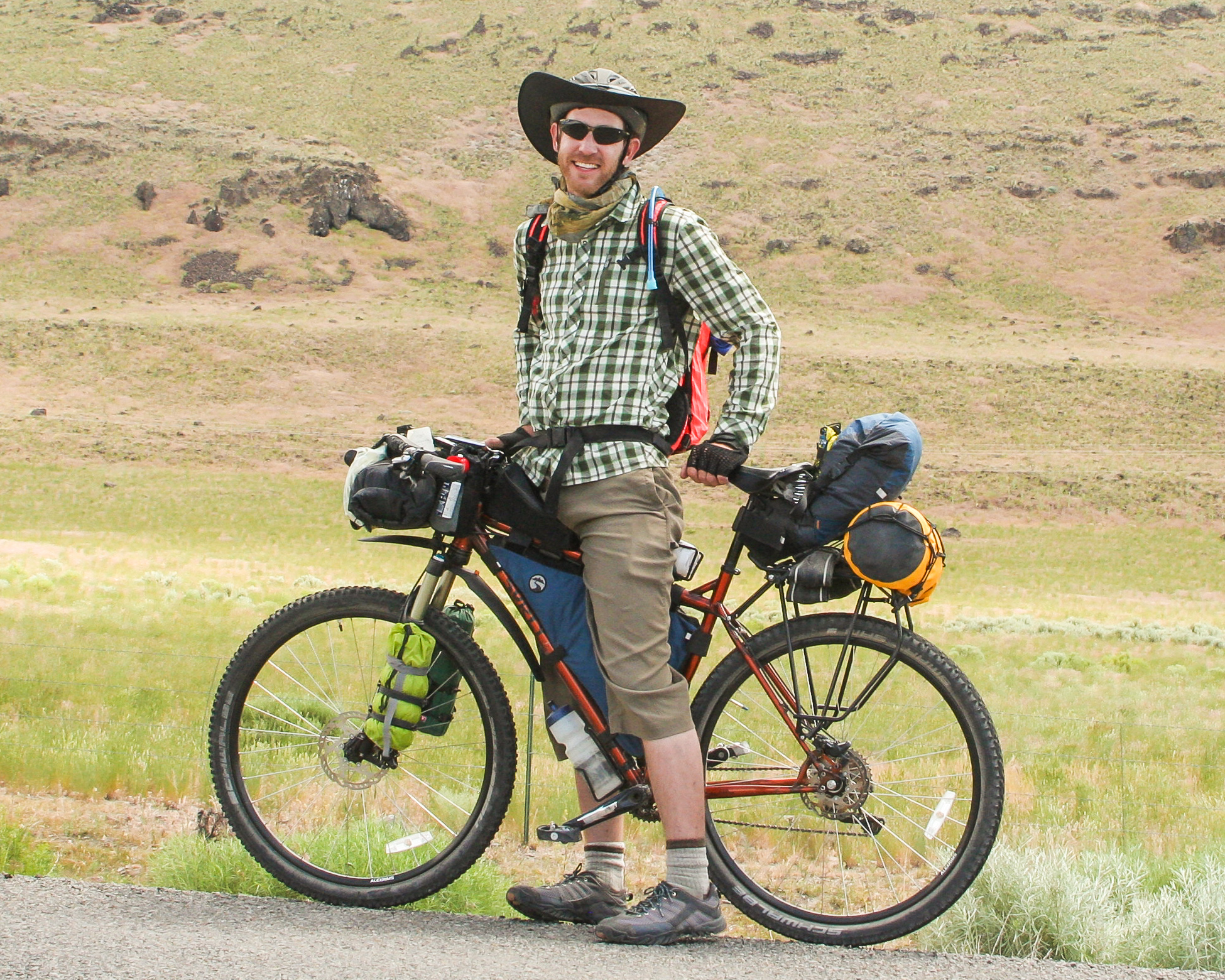
The first time we encountered a bikepacker was in 2016 when we met Wesley on the Steens Mountain Route in Eastern Oregon

We met many more bikepackers on the Great Divide Route (GDMBR).
What are the advantages of bikepacking vs. traditional bicycle touring?
Bikepackers typically carry much lighter loads, so touring in mountainous areas is physically less demanding. Navigating rough terrain such as sand, rocks, steep inclines, and river crossings is easier with a bikepacking set-up.
Of course, riders can tackle all sorts of off-pavement surfaces on a touring bike equipped with racks and panniers, but it’s clearly going to be a bit harder with the additional weight and bulkier set-up.
Bikepacking bags are better for aerodynamics, so you’ll be faster than someone with a pannier set-up carrying the same weight.
Being narrower and having their gear up higher off the ground, bikepackers avoid bag strike and are better equipped for singletrack.
Racks and panniers tend to rattle and shake on rough roads, but bikepacking set-ups are smoother and less noisy.
Some cyclists also believe bikepacking set-ups look a little cooler and more rugged than panniers.
When did the bikepacking movement begin?
Adventurous folks have always ridden their bicycles on rough roads in remote places. Cyclists used to do it fully- loaded with panniers and now they have a choice between panniers and bikepacking gear.
In 2007, bikepacking pioneer Eric Parsons of Alaska-based Revelate Designs designed the first lightweight and functional frame bags. Early adopters to the bikepacking style of touring include Cass Gilbert, Pikes on Bikes, Lael Wilcox, and Joe Cruz.
Are there any disadvantages of bikepacking?
A cut in comfort.
Bikepackers can not carry as much gear as cyclists with panniers. If you switch to a bikepacking set-up, you will have to carefully streamline your gear and cut out a few of the extra comforts. This can be a good thing because minimalist touring means you have less stuff to worry about.
May spend more en route.
Since bikepackers have less carrying capacity, they tend to spend more money on food and lodging. When we biked the Great Divide Route in 2016 with full-loaded panniers, we were able to carry food for up to a week and did not need to shop at pricey general stores in small towns or eat meals in restaurants along the way. Most bikepackers we encountered along the GDMBR regularly re-supplied at convenience stores and ate meals in restaurants along the way.
Packing is trickier.
It’s very easy to stuff your gear in panniers and forget about it. With a bikepacking set-up, good organization is essential. Bikepackers tend to have stuff strapped on their bikes in all sorts of ways and this could be a problem if you encounter rain. Easily accessible and visible gear might also tempt unsavory sorts to snatch stuff off your bike.
With a little experience, most bikepackers soon work out an efficient packing system.
What is the price difference between purchasing bikepacking gear and panniers?
A set of four panniers and bar bag will cost about the same as purchasing a bar bag, saddle pack and frame bag for bikepacking (around $450).
Since bikepackers have less storage space and are usually highly concerned about weight, they often purchase more high-tech gear which generally costs more.
What are the best bikepacking destinations?
Bikepacking is fairly developed in the United States and the American West has many well-documented bikepacking routes.
Popular bikepacking routes include the Great Divide Route (GDMBR), the Arizona Trail and the White Rim Trail in the Canyonlands of Utah.
The Baja Divide Route, carved out by Lael Wilcox and Nicolas Carmen, is becoming popular with riders on their way from Alaska to Ushuaia.
There are also many excellent bikepacking routes through the Andes.
What is better for a long-distance or round the world bicycle tour, panniers or bikepacking bags?
There is no clear cut answer to this and it really depends on how you like to tour.
Most round the world cyclists still opt for a traditional four pannier set-up. Their fully-loaded bikes are able to take them to remote places and they are able to ride on a variety of surfaces from paved highways to steep dirt roads up mountain passes.
A few long-distance cyclists including Tales on Tyres, Riding Wild, Powered by Adobo and the PushBikeGirl have switched to a pure bikepacking set-up. They all report being very happy with their gear arrangements and ability to tackle the roughest of roads.
A hybrid approach may be the best option of all. Check out Mark Watson and Hana Black for their combo of bikepacking gear and panniers.
Based on the blogs I've read, bikepackers tend to incorporate riding over adventurous terrain with bussing-it over the ‘boring bits.’
Many traditional bicycle travelers put a greater value on riding every inch of the way (better known as EFI riders).
There is no one-size-fits-all solution for how to travel by bicycle. They great thing is that today's bicycle adventurers have more options than ever.

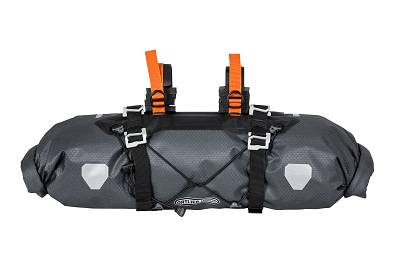


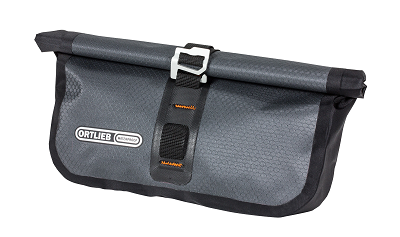



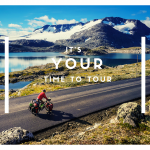
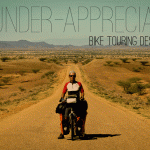
Pretty sketchy on bikepacking aren’t you! Check and you’ll discover “bikepacking” evolved from “backpacking” – hence THE book – when British innovator Robin Adshead introduced Bikepacking in the late 1970s time. Spin the wheel if you want but please do recognise there is heritage and then there is regurgitation of heritage by people who don’t realise they are re-inventing the wheel. But whatever you do, head for the horizon and pack for the journey, enjoy!
Hi Peter,
Thanks for getting us up to speed on bikepacking’s long history. A quick Google search turned up Robin Adshead’s 1978 book “Bikepacking for Beginners” on Ebay.
Amaya, the descriptions above are all spot on. Also, it’s good that you mentioned there’s no clear cut answer to one’s set-up conundrum. I can’t tell anyone to switch to a bikepacking set-up just because it works for us but I’m happy to answer their Q’s. I always emphasize that packing is so personal and it all depends on your priorities, what works for me might not work for you. I always ask bike travellers still how they pack, not to critique but to pick up some tricks that I might not know.
Hi Dean,
Your point is an important one. It’s so easy to fall into the trap of thinking that what works for one unique individual will work for everyone.
Personally, I’d like to go a little lighter, but my husband is dead set against this. When you cycle as a couple, there are two people’s (sometimes conflicting) priorities to take into account.
Hi! Great read. Thanks for writing it! I’ve considered writing a similar post to clarify for people. As a long distance biker (30,000 miles since Northern Alaska to here in Southern Patagonia on as much rough dirt as possible), I’d add a few comments.
Personally I think it’s more of a philosophy than a setup. I’ve met riders who are on full racks and panniers riding rougher stuff than people who are on more standard bikepacking setups. For me it’s more about where you sit on the suffer scale. Do you like riding on rough terrain or prefer the smooth comfort that pavement allows? Are you willing to get off your bike and push it up that hill, trail, though that river, or over that mountain for 2 days straight (while still finding the space for a smile and some joy) or do you prefer to stay in the saddle? Do you mind being around cars, traffic and crowds enough to do the work it takes to get away from them? Do you prefer the community of riding with many other bike tourists (like riding the Pan-American Highway as many cyclists do through the Americas) or do you like the silence of wilderness that only that lonesome mountain trail can afford?
Of course my bias is obvious in the way I’ve worded the questions, but there is no right or wrong answer, they’re just important for clarification. Once you know WHERE and HOW you want to ride, then you have to choose what rig and setup will help you have the best experience you can. If you want to get out into the wilderness, you’l have a hell of a lot more fun if your bike can comfortably handle the terrain and you’re light enough to pedal, push, heave, and shoulder your bike through it. That said, if you can live without an extra change of clothes, a camping chair, your guitar, etc. and value the freedom of remote access the minimalism affords, go for a BP setup. You’ll almost certainly enjoy the experience of RIDING your bike much more than dragging a heavy traditional touring rig through the same terrain. It is all too easy to get caught in the image of what bikepacking bikes look like but miss the point: setting up your bike to carry what YOU need to get to the places that YOU want. If you have frame, handlebar and seatpost bags but also carry a rear rack for a little extra carrying capacity with or without rear panniers, are you bikepacking… or not? My point: it doesn’t matter.
I’ll argue that even if planning to stay on pavement, cutting down on unnecessary weight will raise the joy level on those long climbs as well. For example, I’m a percussionist but opted for an irish penny whistle over heavy drums to keep music in my bones while traveling.
In terms of bikepackers spending more than bike tourists, I’d argue that just on one main angle: The lighter you are the faster you go. The faster you go the further you go. So if one person can cover the same distance in 3 days (with only 3 days of food) that someone else covers in 5-6 days (with twice the weight of food mind you), they can get to the same discount stores with less weight. They also spent money on just 3 days of food vs. 6! That said, the more remote the route, the less discount stores are available anyway, making the point somewhat moot.
Lastly, as an “EFI” rider myself, I think this variable is independent of being a tourer or bikepacker. It’s just about philosophy and dedication. We all travel with our own sets of rules that define what our journey is and how we are doing it. Without intending to be attacking at all, I think it’s oversimplifying the infinite manifestations of our own unique individuality to boil down and group certain traits with certain bike setups. I’ve seen all types of strokes and folks. and love celebrating people’s creativity and individual expressions of the act of travel!
As for me — my first bike tour was the continental divide on a “traditional” bikepacking setup adding a pvc pipe mounted to the rear of the frame for my bamboo flute. For my Alaska to Tierra del Fuego journey, I started heavier adding 2 rear panniers to a bikepacking setup. I slowly over time realized what I didn’t need and have boiled it down to handlebar bags, frame bag, seat bag and a light backpack. If I don’t use something for over a month it gets dumped, sold or given away. I’m still amazed however that I can run into riders who’s setups weigh significantly less than mine, despite being on long-distance months to years long rides. The bottom line is: I LOVE riding bikes. Not just where they can get me to, but being ON the bike day after day. So my goal is making that experience as fun and freeing as possible.
Hi Scott,
Beautifully said! Thanks so much for sharing your insights.
I think you’ve hit the nail on the head when you write:
I’ve seen all types of strokes and folks and love celebrating people’s creativity and individual expressions of the act of travel!
why not a light weight single wheel trailer? I never understood loading weight onto the frame of the bike…
Hi Paul,
Bicycle trailers have fallen out of favor in past years and I’m really not sure why. There is the issue of additional weight, but that’s actually fairly negligible. One issue with trailers is that cyclists tend to throw more stuff in than they actually need just because they have the extra space.
I have riden all three, fully loaded, bike pack, and the trailer. The trailer was great on my tandem and made it easy to dump and go for day rides. Fully loaded has its place just being able to carry more gear, needed as a tour guide. I have traveled solo with my Bikepacking equipment love it to, having backpacked for years. I really think it’s about where and your comfort level.
Hi Creed,
Good point-
The ideal set-up does indeed depend on many factors and can change dramatically depending on where you’re touring. Since we’re full-time bike touring nomads, we don’t have the luxury of tweaking our set-up for different locations but that obviously makes sense if you have the option.
Hi Amaya, thanks for the comparison! I haven’t tried bikepacking but the thought of riding offroad more often is an appealing one.
I wonder though, how bikepackers “tend to spend more money on food and lodging.”
Why lodging? What holds them back from camping as often as pannier-tourers do? Is it a more frequent need for comfort that comes from carrying such minimal luggage?
Also, how much lighter do you think is a bikepacking setup, compared to a four-pannier one?
Thanks again,
Patrick
Yes, you’re right that bikepackers can (and do)camp, but lots of them just carry lightweight shelters which are much more confining than a full-sized tent.
Camping tends to be more fun when you have a few extras along to prepare more elaborate meals and perhaps–if you’re on the road for several months or years- keep yourself entertained with movie night in the tent. We’ve spent hundreds of nights outdoors and I like having my pillow, pajamas, kindle and laptop with me in a spacious tent-it feels just like home.
It’s simply my personal observation that ultra lightweight bicycle travelers (bikepackers) go to hotels and eat in restaurants more often than fully-loaded cyclists.
The point is minimal but the ultra-light crowd tend to be on short intense and high mile days and maybe they are racing or doing it with a competitive frame of mind – not all bikepackers are ‘ultra-light’ (though I guess it’s all relative). Ultra-light bikepackers are kinda like off-road credit card tourers! I think for people who spend most of the year on the road it makes sense they have to carry more stuff.
I bikepacked 3,500 miles over 3 months from Canada down to Mexico and then returned via parts of the Baja Divide. It was my first time with the ‘bikepacking’ setup and a rigid mountain bike with plus tires. It’s true I did eat at restaurants every couple of days but more for an excuse to escape the extreme cold and get some wifi than not having the right equipment to cook. In 50 days I stayed at 1 hotel and 1 airbnb (because of a snowstorm). When I travel it’s to escape electrical devices which I spent all my time on when I’m home 🙂
Even if I returned to road biking I’ll never go back to hauling stuff around in panniers because the sense of freedom of traveling light, is for me, worth a thousand luxuries. I road parts of the Baja divide on a touring bike with narrow tires and two panniers and the riding element was just horrible. Going back with a honed bikepacking setup it was an absolutely blast.
As for touring and bikepacking – having done both, I think there is definitely virtue to each but ultimately bikepacking wins out (for me) because I’m sick and tired of being abused by drivers and having to constantly worry which drunken idiot in an SUV is behind me. In the end I simply get depressed and lose faith in humanity, others no doubt are far less sensitive to this.
To the trailer questions : In my experience, if you are doing super aggressive off road gravel climbs, pulling a lot of weight, the trailer can make a difference between riding and pushing. For example, I pull my daughter with me, in a trailer, and when climbing on the great divide northbound out of southern NM, I filled my 2 liter bladder up, and put it in the far back trunk of the trailer, then tried to ride (I think adding 8 pounds to the 65-70 pounds of trailer+child+toys), and my tires spun out, I couldn’t ride. So I moved the water to inside my panniers, and I pedaled just fine. Now I am 98 pounds, pulling/carrying around 100lbs (for 2 people, so X2), on a heavy 36 pound surly troll, so this situation may be different for someone stronger, but just a reason why some may prefer “on bike”. That being said, when I have a few trailers (most to carry my child) and I like them.
On the bike pack versus “traditional” touring, I see it more as mountain touring versus road touring, as the man said above, it seems more of a cultural ethos than your actual set up. I’ve ridden with a frame bag and 2 small panniers with a tout terrain single wheel child trailer on single track and I’d say that I was mountain touring, versus crossing states on road being road touring…But I like to go over both terrain, so I guess I don’t necessarily see the need to make a distinction other than “I’m biking for a while”. As mentioned, bike packing came from backpacking meaning carting your stuff on a hike, therefore, maybe the difference is between credit card touring, lightweight touring, and heavy touring. Hmm, I guess I’m just not much of a labeler so, I guess I’m not the best person to ask.
Ride on!
Thanks, Megan, for joining the conversation and sharing your experiences.
It’s great that you’re not much of a labeler, because the world’s already got plenty of those.
I admire your determination to schlepp such a heavy load over the GDMBR.
Lot’s of people I’ve met think they’re not strong enough to take on the Great Divide Route, but I think most reasonably fit people can do it as long as they’re not under time pressure.
Would I be corect in assuming another essential piece of equipment for Bikepacking is a Hipster Beard?
My unscientific Instagram research points to a high correlation between male facial hair and bikepacking selfies.
Cass Gilbert wrote an article on the pros and cons of a bikepacking setup versus panniers:
http://www.whileoutriding.com/bikepacking/bikepacking-the-joys-of-travelling-light-and-lean
It’s one of the best articles I’ve come across on the subject.
He also links to Joe Cruz’s article on the subject:
https://joecruz.wordpress.com/2011/12/13/bikepacking-gear-for-touring/
Thanks for sharing these links! It is always helpful to have the perspective from experienced cyclists who have toured both ways.
Lightweight and functional bicycle frame bags were common in Australia, from the 1890’s at least.
The ultimate minimalist bicycle adventurer, Arthur Richardson, used one in 1896 when he became the first to cross by bicycle from Western Australia to South Australia via the Nullarbor desert, and again in1899, when he became the first cyclist to circumnavigate Australia. Nylon frame bags were sold n the 1970,s and 80,s too.
It was common for agricultural workers to cross large distances of arid bush with nothing more than a frame bag, a water bag on the handlebars, and a bedroll tied to the front forks, up until after WW2.
Bike packing/minimalist touring is great, but it’s about as new as pneumatic tyres or safety bicycles.